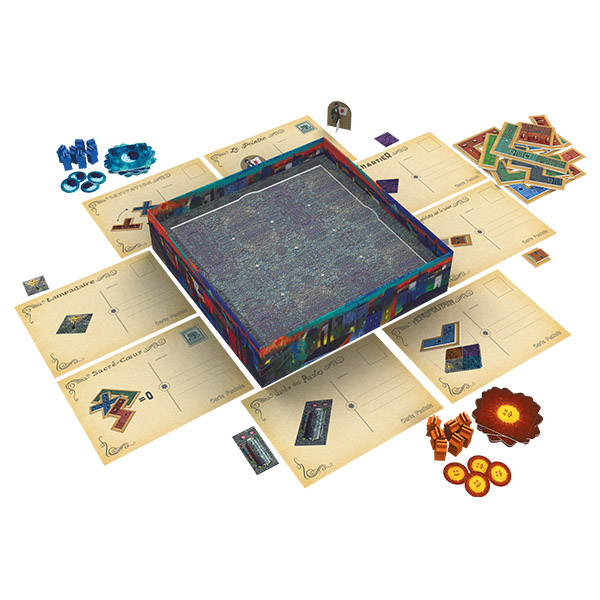Dracula vs. Van Helsing is a new, asymmetrical two-player game (first out in 2023 in Europe) from the co-designers of The LOOP, one of whom also co-designed Sea Salt & Paper, Draftosaurus, and Rauha. This particular game offers a new twist on the capture-the-flag style of two-player games, with a couple of mechanics that make the game extremely tense, where one player can end the round without warning and you often won’t know the results until all of the cards are revealed. I have found it really hard to play well, more so from the Dracula side, which has made it a fun challenge to try. (It’s also at Target if Noble Knight is sold out.)
There’s a little board between the two players with five district and four spaces for humans in each of them. Dracula wins if he infects all four humans in any single area, or if he’s still alive after five rounds; Van Helsing wins if he brings Dracula’s health points from 11 to 0 before that happens. In each round, each player will play one card to each of five regions, moving and swapping cards over the course of the round to try to get the best alignment of cards for the reveal, at which point the cards are compared, with Dracula biting a human if their card wins, and Dracula losing a health point if Van Helsing’s card wins.
The deck has cards from 1 through 8 in four colors, and in each round one color starts out as the trump. At the reveal, a card in the trump color defeats any other color, with the higher trump card winning if they’re both in that color. If neither card is the trump color, the higher number wins, and if they have the same number, there’s an order to the colors that is also variable and then determines the winner.
Each number has a specific action associated with it, and when you discard a card, you take that action. On a turn, you draw the next card from the deck and decide whether you want to discard it or to play it to one of your five spaces, discarding the card that was already there and taking that card’s action. Actions include (in order from 1 to 7) revealing one of your own cards, revealing the next card in the deck, revealing one of your opponent’s card, swapping two of your own cards, taking another turn, swapping one card with your opponent’s card in the same district, and changing the trump suit to one of your choice. The 8 card’s action is to end the round immediately, but you can only do so once there are at least six cards in the discard pile, giving each player a fair chance to compete. Either player can call to end the round without discarding an 8, but that gives the other player one last turn, and that’s a huge risk to take.
At the end of the round, you evaluate each district from left to right, and if either player meets their victory condition, the game ends immediately without evaluating any further districts. If you haven’t played five rounds yet and neither player has won, you reshuffle all cards but leave the trump suit and suit order as they were at the end of the previous round.
I’ve played this a bunch on BGA, and it took me forever to win my first game – for some reason I kept getting the Dracula side – because I wasn’t aggressive enough at protecting my health points. There’s a lot of randomness in any game where you draw one card (tile, whatever) and then must play it immediately, but there’s also a ton of skill in this game around what cards to hang on to and when to ditch certain ones. Swapping the trump color (7) and then ending the round immediately (8) on consecutive turns can be a death blow to your opponent, and the swap cards with your opponent (6) and then ending the round immediately can be almost as good. There are times when it’s okay to reveal one of your own cards, and if your opponent reveals one of yours, maybe you want to ditch that card sooner. There are little strategies with each number and then the broader strategy of protecting yourself while trying to strike surgically (if you’re Dracula) or more broadly (if you’re Van Helsing), and if you play it well you can even overcome some bad card draws. It’s a strong two-player game in the vein of Jaipur or Battle Line, where the competition against your opponent is very intense, but with the added twist of asymmetrical goals even though you play from the same deck.





